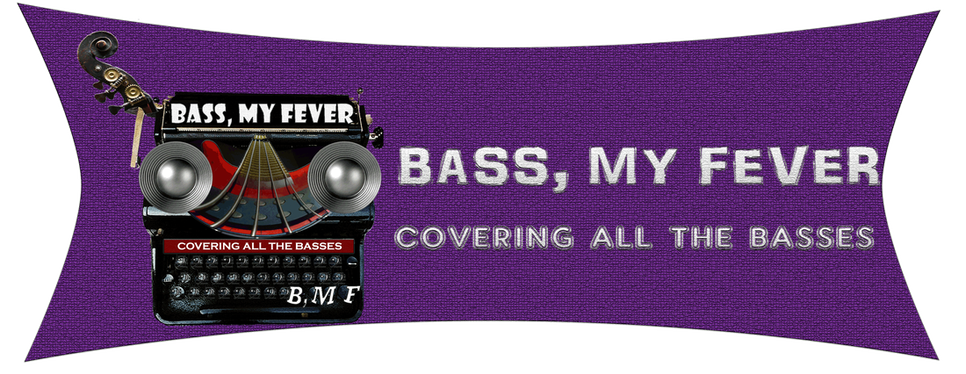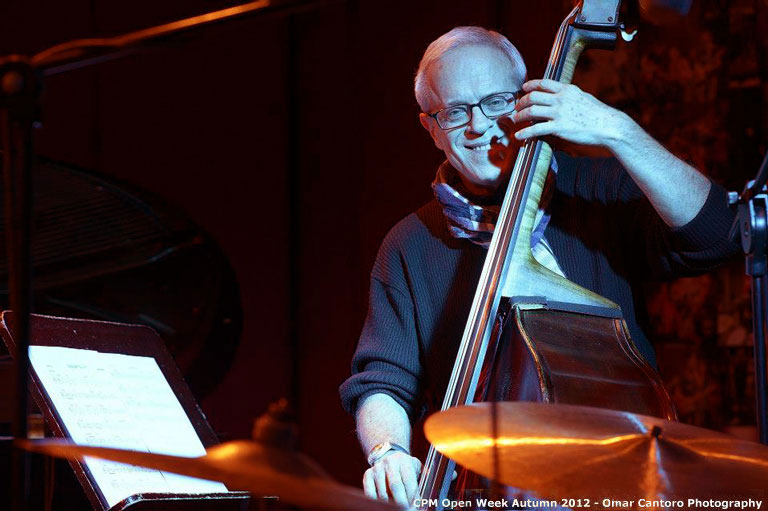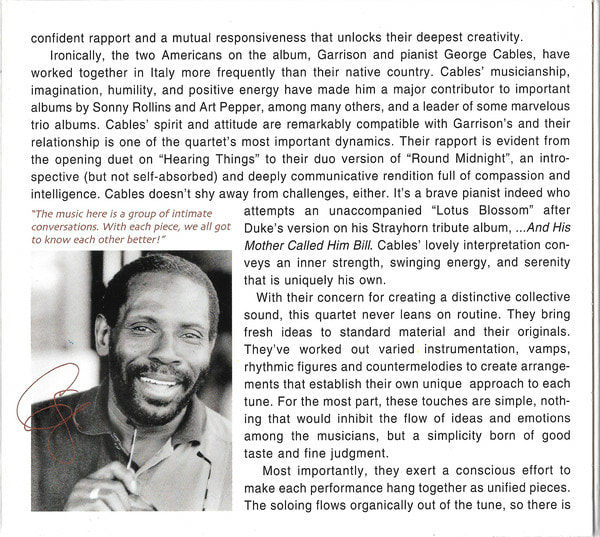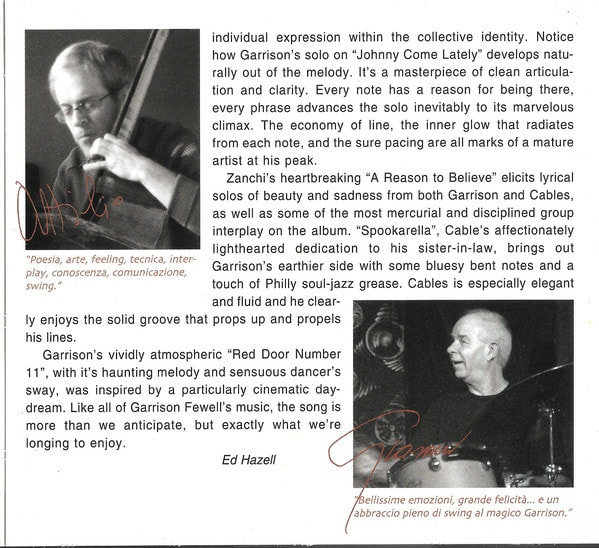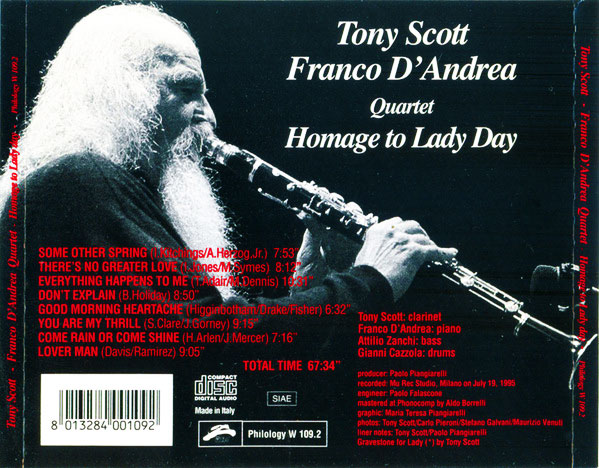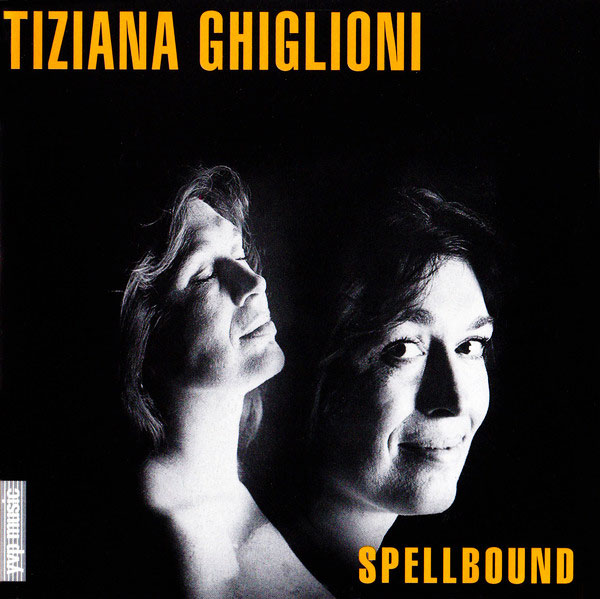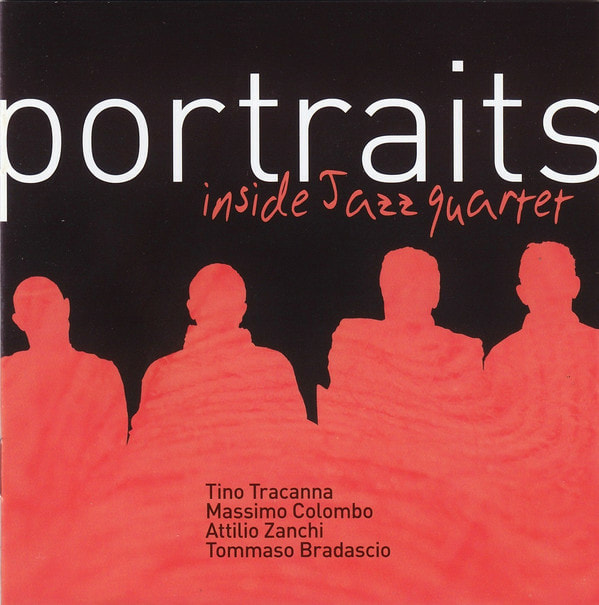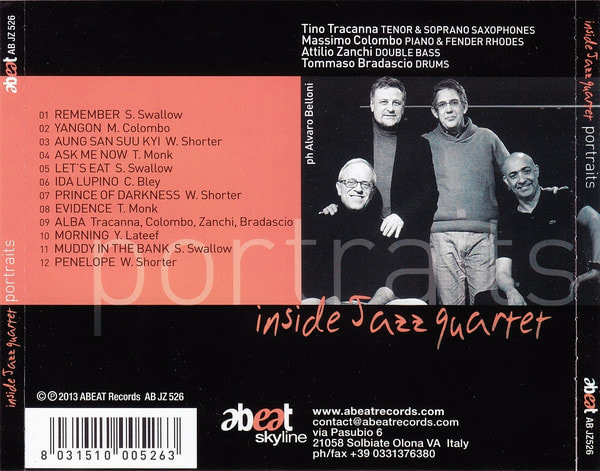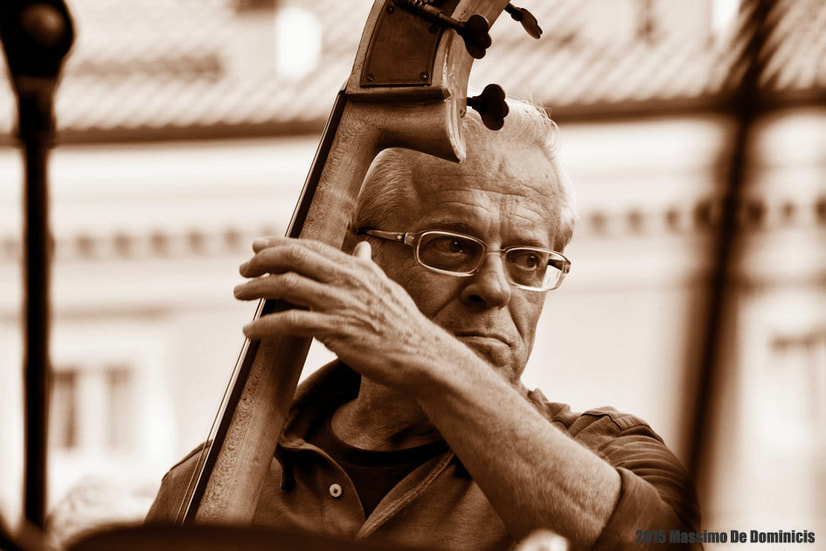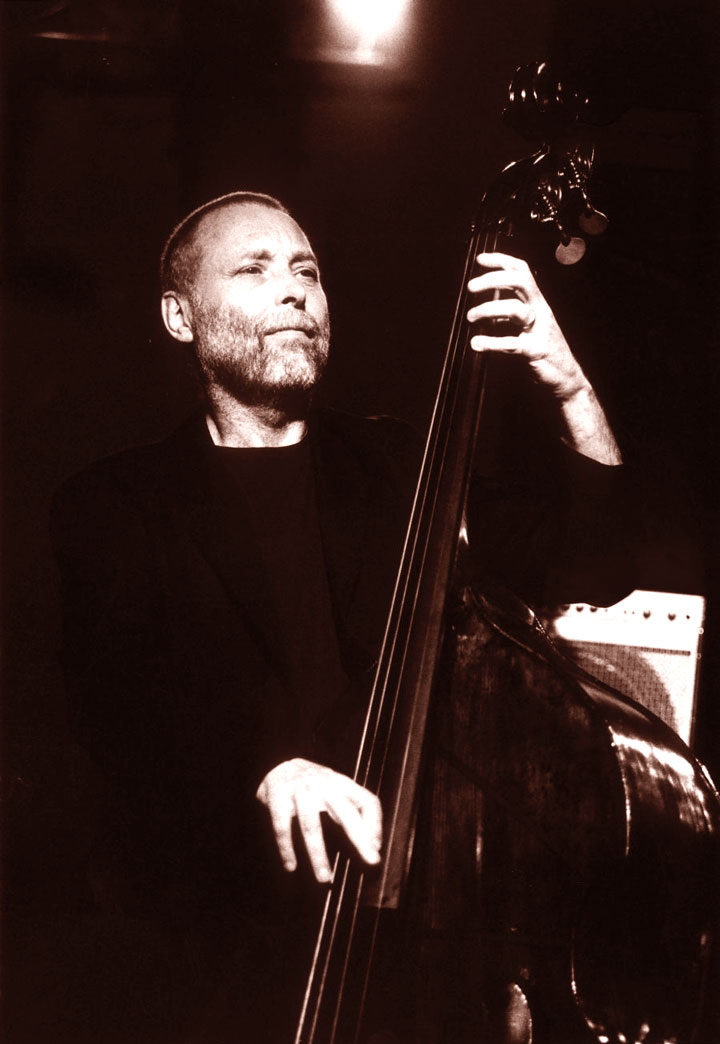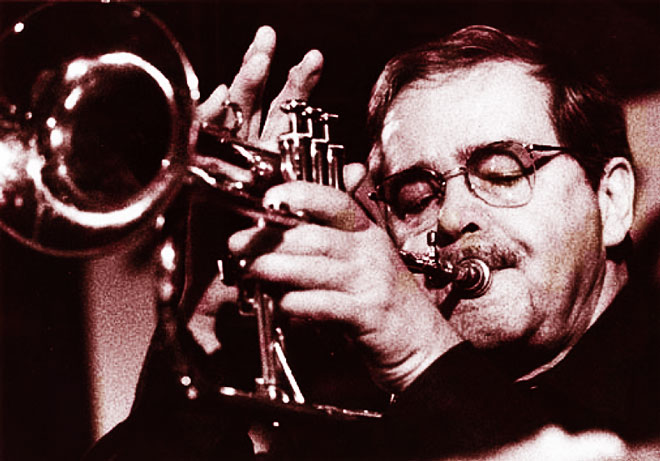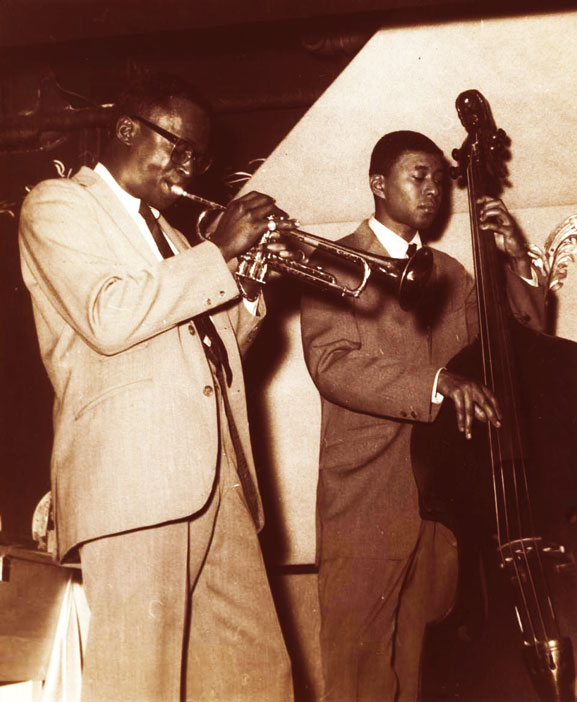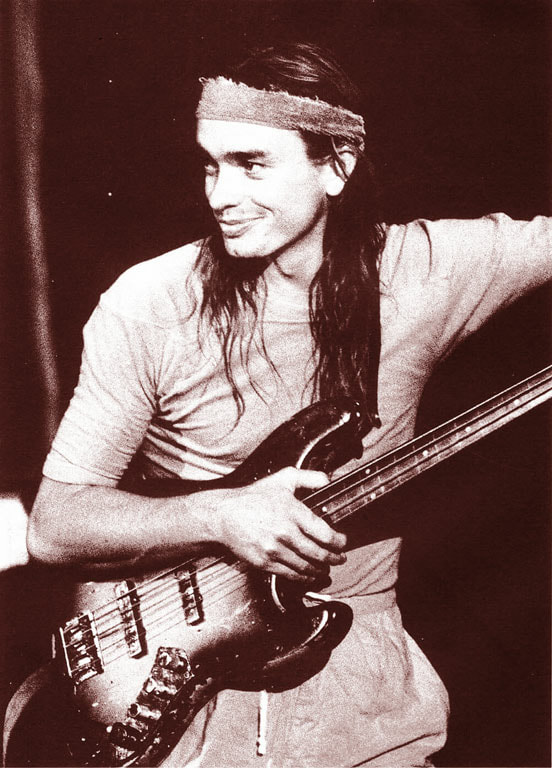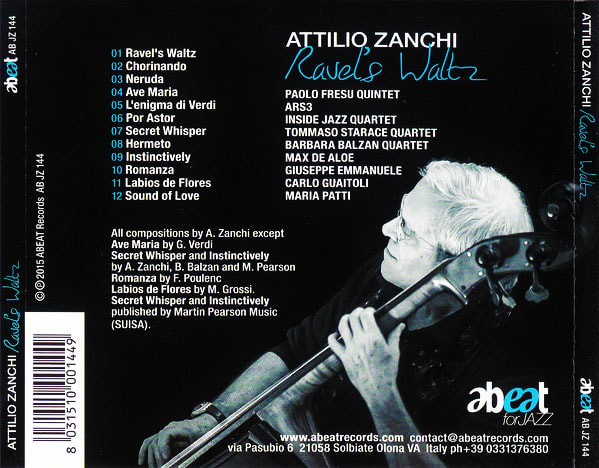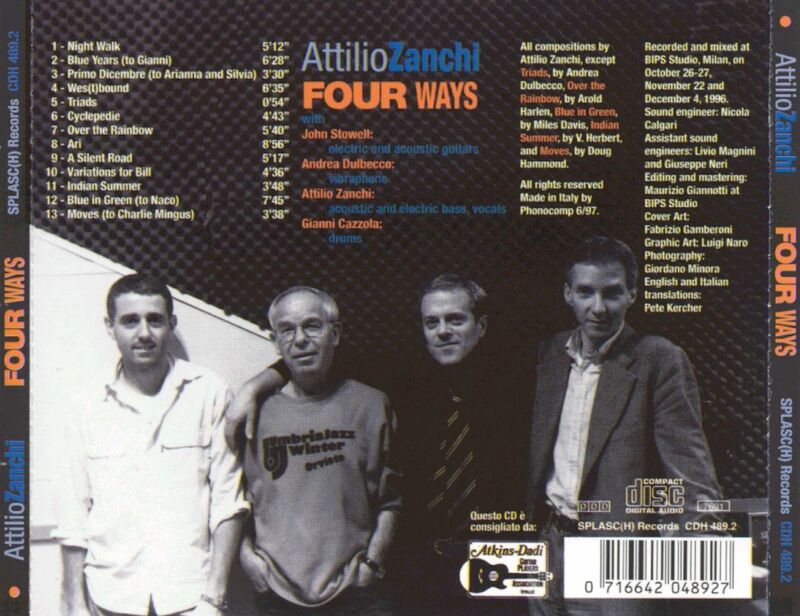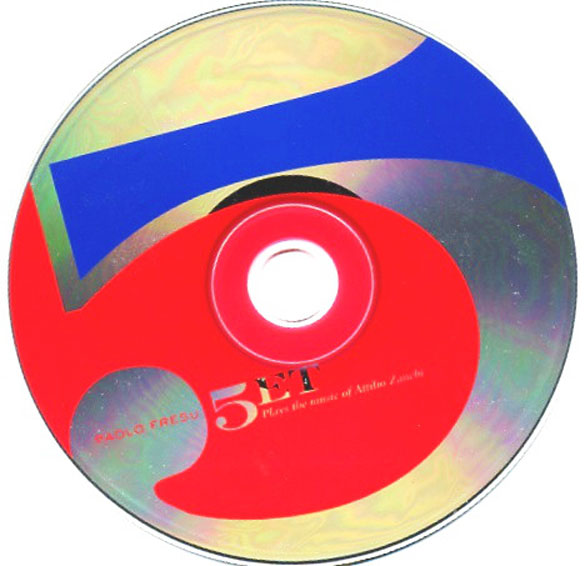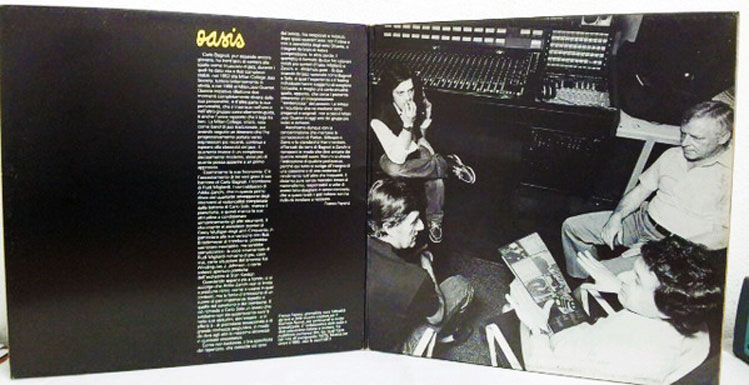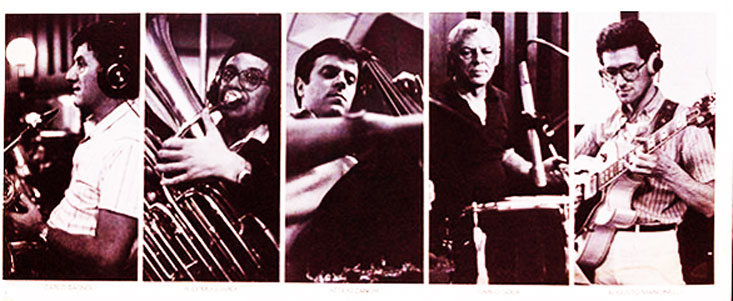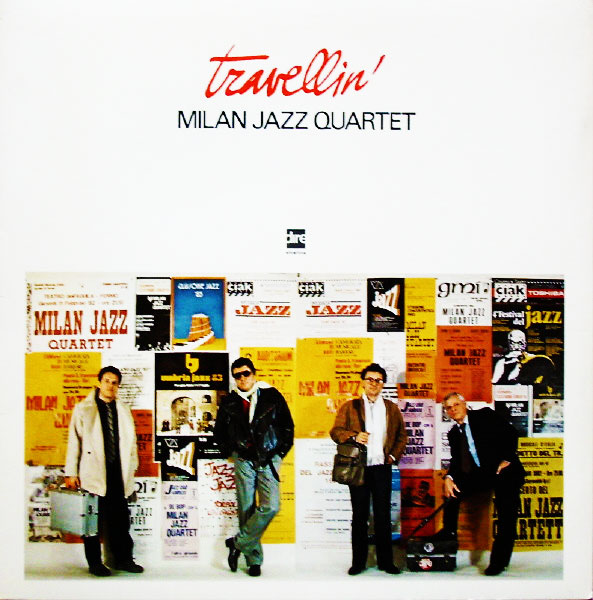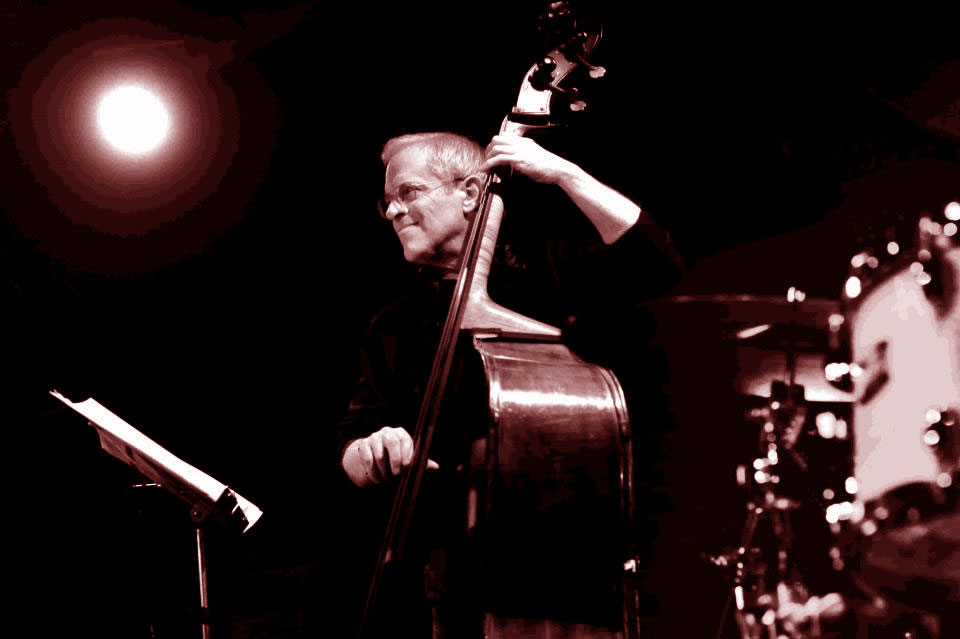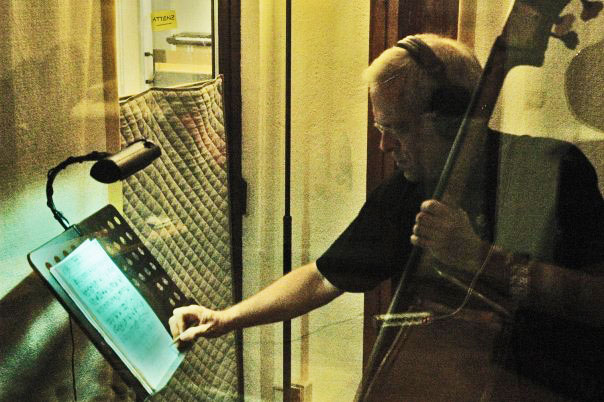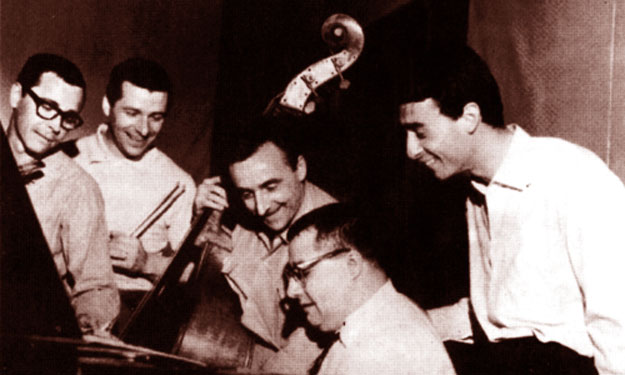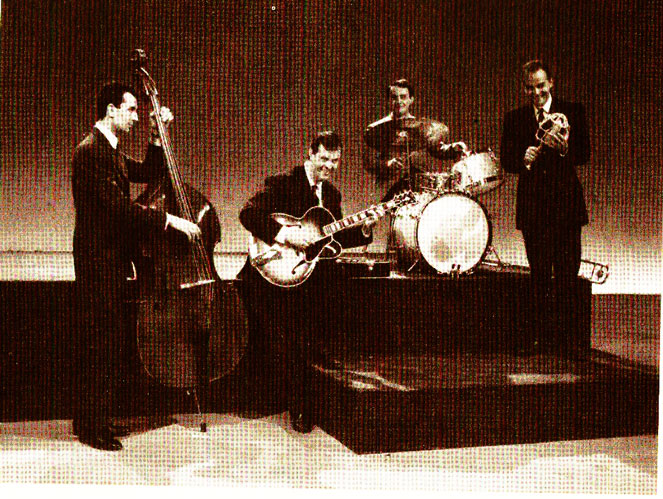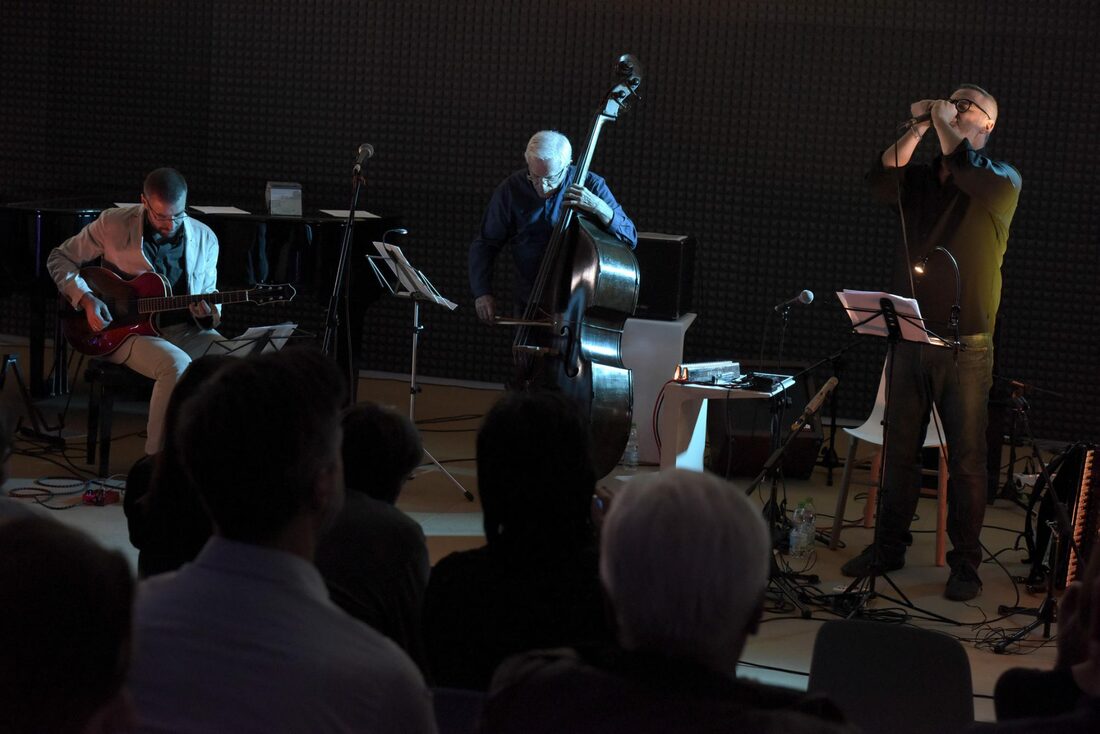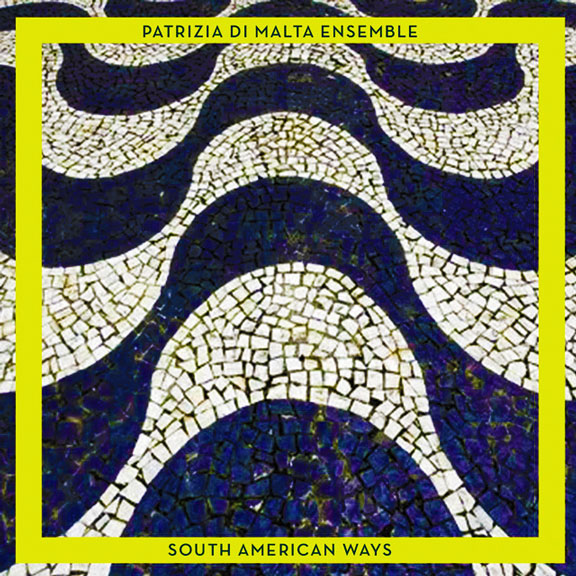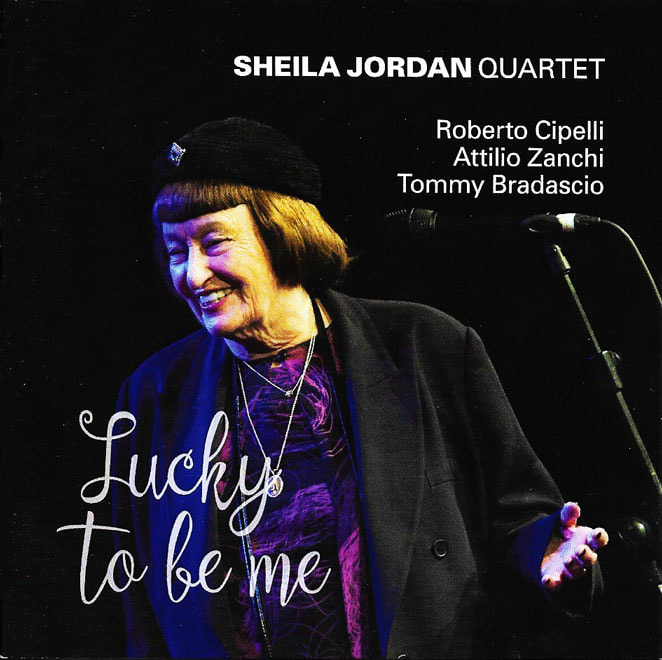INTERVIEW WITH
ATTILIO ZANCHI
ATTILIO ZANCHI
|
«Over the last 30 years there was a huge development of the technical skill as regards both instruments; so today innovative approaches are proceeding slowly. I think that bassists should focus more on music and compositions rather than on the pure technique...»
............ «Negli ultimi 30 anni c’è stato uno sviluppo enorme nella tecnica bassistica per entrambi gli strumenti e quindi oggi i progressi innovativi procedono a rilento. Consiglierei ai bassisti di concentrarsi di più sulla musica e sulle composizioni piuttosto che sulla pura tecnica...» |
|
As a double bass player of rare elegance, in addition to be a solid as well as inventive accompanist - not to mention his refined nature as a leader musician-, Attilio Zanchi is an unlimited and creative artist being active since the beginning of the ‘70s. As a faithful partner of Paolo Fresu for many years, Zanchi can boast an infinite pedigree such as important recordings with Sheila Jordan, Bobby Watson, Garrison Fewell, Franco D’Andrea, Tony Scott, Tiziana Ghiglioni and many other jazz artists and not just it. |
Contrabbassista di rara eleganza, solido ed inventivo accompagnatore, raffinato solista, Attilio Zanchi è un musicista inesausto e creativo attivo sin dai primi albori degli anni settanta. Fedele collaboratore di Paolo Fresu da molti anni, Zanchi ha nel suo sterminato pedigree incisioni con Sheila Jordan, Bobby Watson, Garrison Fewell, Franco D’Andrea, Tony Scott, Tiziana Ghiglioni e tanti altri grandi nomi del jazz e non solo. |
|
His solo albums have always been guarantee of quality thanks to their valuable arrangements and that imaginative purity which is the key aspect of his own personal sound on double bass; Early Spring and Cats are still two amazing and classical albums approached and conceived as a bassist. The excellent Some Other Place released by the sadly extinct DDD (to this day this title is a collector’s item), the precious Four Ways of 1997 released by Splasc(h) with the vibraphone in the lead within an open line-up and the suggestive Ravel’s Waltz of 2015. At the risk of being monotonous, it must be said that every productions of Attilio Zanchi is tinged with a particular light and from this perspective should be considered the works with the late Naco, ARS3 (together with Mauro Grossi and Marco Castiglioni), E.S.P. Trio with Cazzola and Cipelli, not to mention the remarkable Inside Jazz Quartet and the really impressive Project called Sospensiva of 2016. |
I suoi album solisti, nel corso degli anni, sono sempre stati garanzia di grande qualità, con composizioni pregevoli e quell’impeccabilità fantasiosa che è parte integrante della cifra bassistica di Zanchi; Early Spring e Cats sono ancora oggi due splendidi e classici album pensati e concepiti da un bassista. Non vanno dimenticati l’ottimo Some Other Ways per la purtroppo defunta DDD (ad oggi questo titolo è un pezzo da collezione), il prezioso Four Ways del 1997, edito dalla Splasc(h) con una formazione aperta con protagonista il vibrafono e il suggestivo Ravel’s Waltz del 2015. A costo di ripeterci, va detto che ogni produzione di Attilio Zanchi è baciata da una luce particolare, ed in quest’ottica vanno considerati i lavori con il rimpianto Naco, l’ARS3 (con Mauro Grossi e Marco Castiglioni), l’E.S.P. Trio con Cazzola e Cipelli e il notevole Inside Jazz Quartet, senza dimenticare l’interessantissimo progetto Sospensiva, del 2016. |
|
|
|
|
Attilio Zanchi is a musician whom every true jazz enthusiast may know and discover, by stepping into his several collaborations and his deep and famous bass playing. So we leave you to the interview that he kindly gave to “Bass, My Fever”. |
Un musicista che un serio appassionato di jazz e musica non può non conoscere, addentrandosi nelle sue molteplici collaborazioni e nella sua profonda, riconoscibilissima, cavata. Ecco l’intervista che ha gentilmente concesso a “Bass, My Fever”. |
ALL THAT FOR JAZZ: |
TUTTO PER IL JAZZ: |
|
BMF: You studied with Dave Holland in the US and you also went to Canada. Would you like to tell us something about those years? AZ: In the late '70s, there weren’t so many jazz upright bassists in Milan, so for young musicians like me there were more opportunities to perform and gain experience along with senior artists. Moreover many american musicians came alone in Italy and Europe as freelance and some Italian rhythm sections were built so as to accompany them in tour. This happy coincidence allowed me back time to play and learn directly from that original source in addiction to perform along with dozens of important musicians. Among them I can mention Lee Konitz, Tony Scott, Sam Rivers, Joe Farrel, Slide Hampton, Harry Sweet Edison, Mal Waldron, Bobby Watson, Dave Liebman, Al Cohn, Gerry Mulligan, Sal Nistico, Lew Tabackin, Jimmy Knepper, Bob Berg, Louis Hayes, Don Cherry, Roy Hargrove, Chick Corea, Peter Erskine, John Surman, Eddie Lockjaw Davis, Pierre Favre, Phil Woods, John Stowell, Steve Lacy, Gary Burton, Milt Jackson, Sheila Jordan, Mark Murphy, Tom Harrell. |
BMF: Hai studiato con Dave Holland negli Stati Uniti, sei stato anche in Canada. Ci racconti di quegli anni? AZ: Alla fine degli anni ‘70 non c’erano ancora tanti contrabbassisti jazz a Milano e quindi per i giovani come me c’erano più possibilità di suonare e fare esperienze con i musicisti più esperti. Inoltre tanti musicisti americani arrivavano in Italia ed Europa da soli come “freelance” e venivano formate delle ritmiche italiane che li accompagnavano in tour. Questa fortunata coincidenza mi permise ai tempi di suonare ed apprendere direttamente dalla fonte originaria e di esibirmi con decine di musicisti importanti. Fra i tanti ricordo Lee Konitz, Tony Scott, Sam Rivers, Joe Farrel, Slide Hampton, Harry Sweet Edison, Mal Waldron, Bobby Watson, Dave Liebman, Al Cohn, Gerry Mulligan, Sal Nistico, Lew Tabackin, Jimmy Knepper, Bob Berg, Louis Hayes, Don Cherry, Roy Hargrove, Chick Corea, Peter Erskine, John Surman, Eddie Lockjaw Davis, Pierre Favre, Phil Woods, John Stowell, Steve Lacy, Gary Burton, Milt Jackson, Sheila Jordan, Mark Murphy, Tom Harrell. |
|
I knew Dave Holland by meeting him at a concert in Milan and I was impressed and admired by his sound so I asked him to study with him in America. He was really kind and he managed to get me a fellowship in order to take some of his classes at the University Of Fine Arts in Banff (Canada) and at the Creative Music Studio in Woodstock (USA) where I improved the study of double bass together with Dave Holland in addition to improvisation with Karl Berger, George Lewis, Sam Rivers, Jimmy Giuffré, Ed Blackwell, Lee Konitz, Kenny Wheeler, Jack de Johnette and John Abercrombie; all musicians I played with in different gigs. In 1981 I played at the Woodstock Jazz Festival together with Baikida Carroll, Julius Hemphill, Ed Blackwell, Nanà Vasconcelos, Collin Wallcot, Dewey Redman and Howard Johnson, and also with Woodstock Workshop Orchestra. It was a really exciting and training experience for me. |
Dave Holland l’ho conosciuto in un concerto che fece a Milano e rimasi colpito ed ammirato dal suo modo di suonare, così gli chiesi se potevo andare a studiare da lui in America. Lui fu molto gentile e mi fece avere una borsa di studio per frequentare dei corsi che teneva presso la "University of Fine Arts" di Banff (Canada) e presso il "Creative Music Studio" di Woodstock (USA) dove con lui perfezionai lo studio del contrabbasso mentre l’improvvisazione con Karl Berger, George Lewis, Sam Rivers, Jimmy Giuffré, Ed Blackwell, Lee Konitz, Kenny Wheeler, Jack DeJohnette e John Abercrombie con i quali suonai anche in vari concerti. Nel 1981 suonai al Woodstock Jazz Festival con Baikida Carrol, Julius Hemphill, Ed Blackwell, Nana Vasconcellos, Collin Wallcot, Dewey Redman e Howard Johnson e con la "Woodstock Workshop Orchestra". Fu una esperienza veramente appassionante e formativa per me. |
|
|
|
BMF: Besides Dave Holland, who were the most influential double and electric bassists for you? AZ: As regards upright bassists, I listened to and I studied a lot Ray Brown and Paul Chambers; furthermore, I have to mention the great innovator Scott LaFaro who revolutionized the whole technical skill. With respect to electric bassists I can’t help but mention Pastorius even thoung the one I feel closer to my own style is Steve Swallow whom I admire so much also as a composer. |
BMF: Oltre naturalmente a Dave Holland, quali sono stati i contrabbassisti (e bassisti elettrici) che ti hanno influenzato maggiormente? AZ: Per quanto riguarda i contrabbassisti ho ascoltato e studiato tanto Ray Brown che Paul Chambers, inoltre il grande innovatore Scott La Faro che rivoluzionò tutta la tecnica strumentale. Per quanto riguarda i bassisti elettrici non si può fare a meno di nominare Pastorius, anche se quello che reputo più vicino al mio stile è Steve Swallow, che ammiro tanto anche come compositore. |
|
BMF: As concerns your activity as a leader, even though you recorded more than one hundred albums with the best italian and international jazz musicians, in a sense you have limited the albums under your name, which are all high-level works. Would you like to draw an emotional map of your records as a leader, starting from “Early Spring” and “Cats” to get to the latest and extremely successful “Ravel’s Waltz”? AZ: I’m very devoted to my first solo album called Early Spring because it includes a series of musical experiences shared with many musicians with whom I was collaborating at that time. And while I was thinking about who to call for recording, I realized that some compositions of mine were designed for some specific artists while other ones were more suitable for different musicians. After the album Cats released with my quartet, I recorded other works together with E.S.P. Trio, in which I played an active role as regards compositional aspects even though I wasn’t a leader. Another production which I think is well done is the album “Some Other Place” where you could find some great musicians like Kenny Wheeler, John Taylor, Franco D’Andrea, Gianluigi Trovesi, Paolo Fresu and many others. Afterwards I started the Trio ARS3 together with Mario Grossi and Marco Costiglioni with whom I recorded two albums. In the years that followed I’ve always released my own compositions on the cds recorded with Paolo Fresu and on some other works shared with other artists. My latest album “Ravel’s Waltz” took shape in the same way because I mainly wanted to document my new compositions and I was anxious to achieve a variety both as regards timbre and in terms of interpretation in order to develop my tunes to the fullest. |
BMF: Riguardo alla tua attività come solista, pur incidendo più di cento dischi con i migliori musicisti jazz italiani e internazionali, hai in un certo senso limitato gli album a tuo nome. Che però sono tutti di livello davvero alto. Ci puoi tracciare una mappa “emotiva” delle registrazioni a tuo nome, partendo da Early Spring e Cats, arrivando al recente e riuscitissimo Ravel’s Waltz? AZ: Sono molto affezionato al primo disco fatto da solista che è Early Spring perché racchiude una serie di esperienze musicali fatte con tanti musicisti con i quali collaboravo allora. Mentre stavo pensando a chi chiamare nella registrazione realizzai che alcune mie composizioni si adattavano meglio a certi musicisti ed altre ad artisti diversi ed infine decisi di coinvolgerli tutti. Dopo il disco Cats inciso con il mio quartetto ho fatto altre registrazioni con l’E.S.P. Trio , dove anche se non comparivo come leader in realtà avevo avuto un ruolo attivo nella parte compositiva. Un'altra produzione mia che ritengo riuscita è quella del disco Some Other Place dove erano presenti alcuni grandi musicisti quali Kenny Wheeler, John Taylor, Franco D’Andrea, Gianluigi Trovesi, Paolo Fresu e altri. Successivamente ho formato ARS3 in trio con Mauro Grossi e Marco Castiglioni e con loro abbiamo registrato due Cd. Negli anni seguenti ho sempre pubblicato mie composizioni nei lavori realizzati con con Paolo Fresu ed in quelli di altri musicisti. Il mio ultimo album Ravel’s Waltz è nato un po’ nello stesso modo perché ho voluto documentare principalmente le mie ultime composizioni e ci tenevo ad avere una varietà interpretativa e timbrica per rendere al meglio i brani. |
|
|
|
|
BMF: We want to focus on “Four Ways”, which we think is a fantastic work, with a successful line-up consisting of Gianni Cazzola, Andrea Dulbecco and the great guitarist John Stowell, who was a memorable collaborator of another amazing double bass player, David Friesen. Why, in that album, did you choose to give vibraphone a pianistic role? And then Stowell’s sound worked great along with your upright bass… AZ: I think that this record is one of the most successful. I like so much the sound built on the combination of vibraphone and electric guitar. I think that they blend better than the union of piano and guitar. I met John during a tour in Canada and I was really impressed by his so original way to play. Moreover Andrea Dulbecco is an oustanding musician and their collaboration made it possible to create an excellent work. |
BMF: Vorremmo soffermarci su “Four Ways”, che crediamo sia un lavoro fantastico, con una formazione vincente composta da Gianni Cazzola, Andrea Dulbecco e il grande chitarrista John Stowell, storico collaboratore di un altro grande del contrabbasso come David Friesen. Come mai, per quell’album, scegliesti di dare al vibrafono un ruolo pianistico? E poi il chitarrismo di Stowell si sposava a meraviglia con il tuo contrabbasso… AZ: Ritengo questa registrazione come una delle più riuscite, mi piace molto il suono che viene prodotto dalla combinazione di vibrafono e chitarra elettrica. Penso che si amalgami meglio rispetto all’unione di piano e chitarra. Conobbi John in un tour che feci in Canada e mi colpì molto il suo modo così originale di suonare. Andrea Dulbecco poi è un musicista eccezionale e la combinazione fra i due ci fece realizzare un ottimo disco. |
|
BMF: You’re one of those bassists who chose both electric and upright bass, even though over recent years you’re mainly focused on double bass. Lately in an interview you have rightly stated that both instruments are very different. So we just want to ask you, is the emancipation of bass and double bass completed or is there still a chance for a further expressive revolution?As regards upright bass, Blanton and LaFaro paved the way to new concepts as Jaco and Steve Swallow did on electric instrument. What’s your opinion about that? AZ: Over the last 30 years there was a huge development of the technical skill as regards both instruments; so today innovative approaches are proceeding slowly. I think that bassists should focus more on music and compositions rather than on the pure technique. BMF: Your partnership with Paolo Fresu, a more than 30 years collaboration, is a rare model of creative longevity and loyalty. All the albums you have recorded with Fresu are of high-quality and we also want to mention that beautiful work dedicated to your compositions (P.A.R.T.E). How do you explain this magic alchemy? AZ: We have sometimes talked about that and this is an aspect which we cannot put into words. Everytime (or nearly everytime) we go on stage, a sort of magic alchemy takes shape and this is simply the sum of our five personalities. A lot of it is due to our long music collaboration which allows us to improvise without planning anything before the concerts. |
BMF: Sei uno di quei bassisti che ha sposato sia lo strumento elettrico che l’acustico, anche se negli ultimi anni ti stai dedicando principalmente al contrabbasso. In una tua recente intervista hai dichiarato, giustamente, che si tratta di due strumenti assai differenti. E allora ti chiediamo, l’emancipazione di basso e contrabbasso è finita o c’è ancora la possibilità di qualche rivoluzione espressiva? Nel contrabbasso Blanton e LaFaro hanno aperto la strada a nuove concezioni, come Jaco e Steve Swallow nell’elettrico. Quale la tua opinione al riguardo? AZ: Negli ultimi 30 anni c’è stato uno sviluppo enorme nella tecnica bassistica per entrambi gli strumenti e quindi oggi i progressi innovativi procedono a rilento. Consiglierei ai bassisti di concentrarsi di più sulla musica e sulle composizioni piuttosto che sulla pura tecnica. BMF: La tua partnership più che trentennale con Paolo Fresu è un rarissimo esempio di longevità e fedeltà creativa. Tutti i dischi incisi con Fresu sono di alto livello e vogliamo ricordare quello splendido dedicato alle tue composizioni (P.A.R.T.E). Come spieghi questa magica alchimia? AZ: Ne abbiamo parlato a volte fra di noi ed è una cosa che non riusciamo a spiegare a parole. Ogni volta (o quasi) che saliamo sul palco si forma una magica alchimia che è data dalla somma delle nostre cinque personalità. Molto è dovuto al fatto che abbiamo suonato insieme così tanto che riusciamo a seguirci senza bisogno di pianificare molto la musica prima di salire sul palco. |
|
BMF: Following on from your discography as a leader, is there any possibility that your early works will be reissued, as already happened with “Some Other Place” thanks to the mythical label DDD? And what about the works with the legendary Milan Jazz Quartet? Those albums were and still are in such high demand by the italian jazz enthusiasts and not just them… AZ: I'd really appreciate it, if the album “Some Other Place” will be reissued; they proposed the idea to do that but nothing happened. As regards other cds I find it difficult because the sales are currently so small that labels don’t invest into these kind of productions anymore. BMF: And speaking of italian jazz, you said that “the state of the Art” seems to be better than good and really vivid, too. Anyway there are few locations where musicians can play and however you have advised many young artists to consider a career out of our country. What’s the attention in Italy to Jazz today? AZ: In Italy this is not a good time both for jazz music and musicians. Moreover the Institutions attach a little importance to them, also because the funds allocated to Culture are being constantly cut. In the ‘80s there were television and radio shows dedicated to Jazz which gradually disappeared so the general public ignore this language. This music will continue to exist but new means of distribution have to be found. One of them is Internet which could give an illimited visibility but that is why it appears to be too fragmented and particularly unprofitable. |
BMF: Tornando per un attimo alla tua discografia solista, c’è qualche possibilità che i tuoi due primi lavori possano essere ristampati, così come il bell’episodio con la mitologica label DDD, Some other place? E i lavori con il leggendario Milan Jazz Quartet? Erano e sono dischi molto richiesti dagli appassionati di jazz italiano e non solo… AZ: Mi piacerebbe tanto che venisse ristampato il cd Some other Place, se ne era parlato ma al momento non è successo ancor niente. Per gli altri lavori la vedo difficile perché oramai le vendite sono così esigue che le case discografiche non investono più in queste produzioni. BMF: E a proposito di jazz italiano, hai dichiarato che lo “stato dell’arte” ti sembra più che buono e vivido, ma che ci sono pochi luoghi per suonare e hai comunque consigliato a molti giovani musicisti di tentare anche la strada estera. Che attenzione ha il nostro paese per la musica jazz, oggi? AZ: In Italia non è un buon periodo per la musica Jazz e per i musicisti e l’attenzione data dalle istituzioni è veramente scarsa, anche perché i fondi destinati alla cultura vengono continuamente tagliati. Negli anni ‘80 vi erano programmi televisivi e radiofonici dedicati al Jazz che sono progressivamente spariti e quindi il grande pubblico non è più a conoscenza di questo linguaggio. Questa musica continuerà ad esistere ma bisognerà trovare altri canali di diffusione. Uno di questi è Internet che potrebbe permettere una visibilità illimitata ma proprio per questo motivo risulta dispersivo ed inoltre offre dei guadagni irrisori. |
|
BMF: Education has been an important part of you career, for a long time. You have also written books and bass methods of the highest profile. What does a young artist have to consider before choosing to play Jazz and in particular your instrument? AZ: I think that this choice should be based on a sencere love for music in addiction to a need of it. Everybody cannot think to make it a job that simply allows him to earn a living. You have to move and gain a lot of experiences even abroad in order to build a network of contacts with musicians from any part of Italy and the world. BMF: Would you like to talk about your compositional approach? AZ: I usually compose in two ways. Firstly it comes to mind a melody and I try to keep it in my head so as to write it down as soon as I can. Later I work on harmonization shifting on the piano. Secondly it may happen that while I am playing on double bass or on piano I could create something new and I’m curious about so this is a process tied to playing and only then I put all into pentagram. And after that I always ask myself if it’s not about a melody that anyone has already composed and that I’ve simply remembered, in that case if I like it very much I take some melodic suggestions from that idea and I turn them into something personal. |
BMF: L’insegnamento è una parte fondamentale della tua carriera, da tanto tempo. Hai scritto anche libri e metodi di alto profilo. Cosa deve mettere in conto un giovane che decide oggi di suonare jazz? E in particolare il tuo strumento? AZ: Ritengo che chi sceglie di suonare oggi deve farlo perché ama sinceramente la musica e non ne può fare a meno. Non può pensare di farne un lavoro che gli permetterà di guadagnare i soldi necessari a vivere. Bisogna muoversi e fare esperienze anche all’estero e crearsi una rete di contatti con musicisti in varie parti dell’Italia e del mondo. BMF: Ci puoi parlare del tuo approccio compositivo? AZ: Ci sono due modalità con le quali compongo. La prima è quella dove mi viene in mente una melodia e quindi cerco di tenerla a mente e di scriverla appena ne ho la possibilità. Successivamente lavoro sull’armonizzazione passando al pianoforte. Nel secondo caso invece può succedere che mentre suono il contrabbasso o il piano suoni qualcosa di nuovo che mi incuriosisce e quindi è più un processo legato alla manualità, anche in questo caso trasferisco poi tutto sul pentagramma. Dopo di che mi chiedo sempre se non è per caso una melodia che ha già scritto qualcuno ed io l’ho semplicemente ricordata; in quel caso, se mi piace tanto, prendo alcuni spunti melodici da quella idea e la trasformo in qualcosa di personale. |
|
BMF: I’d like to ask you something about the tradition of italian double bass players which was the birthplace of some remarkable figures over the years: you, Giorgio Azzolini, Maurizio Majorana, Giovanni Tommaso, Furio Di Castri, Marcello Melis in free context and many others. Can you advise our readers any rising (or hiding) names to follow with more attention? AZ: One of the latest double bass players currently coming to the fore is Matteo Bortone. I also mention one of my students at the Conservatory, he’s young and very skilled, his name is Stefano Zambon. BMF: In 2017 it has been released City Of Dreams with De Aloe and Cominoli, in addition to the second chapter of the excellent Inside Jazz Quartet. What about your current projects? AZ: It has been recently released an album recorded with a group of interesting ex students of mine. It’s called Highlights and there’s Giovanni Digiacomo on sax, Gen Cotena on guitar and Alfonso Donadio on drums. Morevover there’s the cd entitled South American Ways by the singer Patrizia Di Malta dedicated to Brazilian music. Then it will be also released a cd dedicated to Billie Holiday recorded with the singer Sonia Spinello. It came out a live album with Sheila Jordan, Roberto Cipelli and Tommy Bradascio. In the autumn we’re going to release a live recording with Inside Jazz Quartet. It has been also published a bass method which includes some studies about Standards |
BMF: Vorremmo chiederti qualcosa sulla scuola contrabbassistica italiana, che ha prodotto negli anni esponenti notevoli: tu, Giorgio Azzolini, Maurizio Majorana, Giovanni Tommaso, Furio Di Castri, Marcello Melis in ambito free e molti altri. Puoi suggerire ai nostri lettori qualche nome emergente (o nascosto!) da seguire con attenzione? AZ: Uno degli ultimi contrabbassisti uscito alla ribalta è Matteo Bortone. Suggerisco anche un mio allievo del Conservatorio di Milano, è giovane e già molto bravo, si chiama Stefano Zambon. BMF: Nel 2017 sono usciti “City of Dreams” con De Aloe e Cominoli, oltre al secondo capitolo dell’eccellente Inside Jazz Quartet. Quali i tuoi programmi, discografici e concertistici, per il 2018? AZ: È uscito da poco un Cd fatto con un gruppo di interessanti miei ex allievi. Il quartetto si chiama Highlights ed ha Giovanni Digiacomo al sax, Gen Cotena alla chitarra e Alfonso Donadio alla batteria. Inoltre il cd South America Ways della cantante Patrizia Di Malta dedicato alla musica brasiliana. Uscirà poi un Cd dedicato a Billie Holiday registrato con la cantante Sonia Spinello. Nel 2018 è uscita anche una bella registrazione effettuata dal vivo con Sheila Jordan, Roberto Cipelli e Tommy Bradascio. È in procinto di pubblicazione un cd fatto dal vivo con Inside Jazz Quartet. Infine è uscito un nuovo metodo contenente degli studi sugli Standards. |
|
BMF: We’d like to close with one of your personal memories about two great musicians whom you knew, that is to say Massimo Urbani (you shared with him the Franco D’Andrea Trio) and the late Stefano Cerri… AZ: Massimo was one of the greatest italian jazz artists, he was a real force of nature and when he was in shape it wasn’t easy, no one could keep up with him. If he lived long enough and stayed healthy he could have done fantastic things. I shared with Stefano the classrooms of Cpm School where we both taught and it was a pleasure stay with him, he was a very kind person in addition to be an amazing musician and a great teacher. |
BMF: Vorremmo avere un tuo ricordo personale di due grandi musicisti che hai conosciuto, Massimo Urbani (con cui hai suonato con il Franco D’Andrea Trio) e il compianto Stefano Cerri… AZ: Massimo è stato uno dei più grandi musicisti jazz italiani, era una vera forza della natura e quando era in forma non era facile stargli dietro. Se fosse vissuto di più e fosse stato in salute avrebbe potuto fare grandi cose. Con Stefano abbiamo diviso le aule della scuola Cpm dove insegnavamo entrambi ed era un piacere stare con lui, era una persona molto gentile ed un gran musicista e didatta. |
|
|
|
|
BMF: What about your gear? AZ: I play a german double bass Torna of the 19th century with Thomastick light strings. My pick up is built directly on the bridge and it’s a creation of the liuther from NY, Richard Barbera. As amps I’ve been using for years an Acoustic model of Mark Bass which is also very powerful in addition to be really light. I play electric bass only if required. I own a Fender Jazz of the ‘70s, a Frudua six strings and an Epiphone which is semi acoustic. BMF: In your long experience as a teacher you have also been at the Conservatory of Naples. What’s your memory about that period and the city? AZ: I have good memories of the city and of how I was welcomed by the then-Director Roberto De Simone. It was my first experience as a teacher at the Conservatory for me and since then I have drown up an educational strategy in order to teach to every musicians. |
BMF: Quale è la tua strumentazione attuale? E in riferimento al basso elettrico, quand’è che scegli di utilizzarlo? Per il jazz, come tu stesso hai opportunamente dichiarato, la scelta del contrabbasso è inevitabile… AZ: Il contrabbasso che utilizzo in concerto è uno strumento tedesco dell’ottocento con corde Thomastick light. Il pick up è costruito direttamente nel ponte ed è del liutaio di New York Richard Barbera. Come amplificatore utilizzo da anni il Mark Bass modello Acoustic che oltre ad essere molto leggero è molto potente. Il basso elettrico lo utilizzo oramai solamente se mi è richiesto. Posseggo un Fender Jazz anni ‘70, un Frudua a sei corde ed un Epiphone semiacustico. BMF: Nelle tue plurime esperienze di insegnamento, sei stato al conservatorio di Napoli. Che ricordo conservi di quel periodo e della città? AZ: Ho un bellissimo ricordo della città e di come sono stato accolto dal Maestro Roberto De Simone che allora era il Direttore. È stato il primo anno di insegnamento nei Conservatori per me e da allora ho elaborato una metodologia didattica per poter insegnare a tutti gli strumentisti. |
|
BMF: Would you like to share with us your musical experience with Sheila Jordan? How do you manage to find your own dimension and the balanced interplay with the expressivity and the different shades of a voice whatever is the line-up in which you play (duo, trio etc.) AZ: I like very much to play with singers and hence having the chance to collaborate with the great Sheila, it seems like a dream to me. In addition to embody the history of Jazz she has a deep emotional strength and she is able to communicate it to the public as well as to musicians by getting right in the heart of every body. When you accompany a singer you have to give her the support she deserves but without exaggerating the melodic phrases in order to provide her a solid base on which she could sing. |
BMF: Puoi parlarci della tua esperienza con Sheila Jordan? Come riesci a trovare la tua dimensione ed il giusto interplay con l’espressività e le sfumature di una voce a prescindere dal tipo di formazione in cui ti trovi (duo, trio etc.)? AZ: Mi piace molto suonare con le cantanti e quindi poter collaborare con la grande Sheila è per me un sogno. Oltre ad incarnare la storia del Jazz ha una grande forza emozionale e riesce a trasmetterla al pubblico ed a noi musicisti arrivando dritta al cuore. Quando si accompagna una cantante bisogna darle il giusto sostegno senza esagerare nei fraseggi ed aiutarla fornendole una base solida sulla quale poter cantare. |
